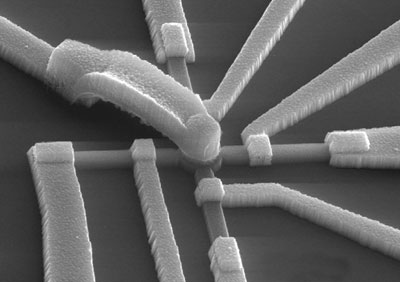MoldERA
Preparation for Moldova's integration into the European Research Area and into the Community R&D Framework Programs on the basis of scientific excellence
New nanostructure combines memory and logic elements
14.02.2011A new way to make complete and programmable logic circuits that combine both memory and logical processing in a single structure has been unveiled by physicists in Germany. Such structures could lead to smaller, faster and more energy-efficient integrated circuits and their development has been one of the main goals in spintronics – a relatively new technology that exploits the spin of an electron as well as its charge. The researchers believe that the structure could lead to a new way of designing logic circuits in which the memory and logic elements are no longer separated.

The tiny logic and memory device
"Single spintronics devices have been demonstrated for quite a while now but we have demonstrated a complete and programmable logic circuit – and that's new," said team leader Laurens Molenkamp at the University of Würzburg. The new circuit is made of a ferromagnetic semiconductor containing a mix of gallium, manganese and arsenic ((Ga,Mn)As) that combines read/write capability with a logical process.
Spintronics devices exploit the fact that the spin of an electron can point in an "up" or "down" direction and switching between these two directions is a property that could be used to store and process information. Such circuits would be smaller and more efficient than conventional silicon-based electronic circuits – which rely on switching charge alone – because, in principle, switching spins from up to down can be done using very little energy. Spintronics devices would carry or manipulate information via a "spin current", which consists of electrons with opposite spins moving in opposite directions.
Strain relaxation
When deposited as a 2D layer, (Ga,Mn)As is most easily magnetized along one of two directions – both in the plane of the layer and at right angles to each other. The Würzburg researchers had already discovered that if they patterned such layers into narrow wires, a phenomenon known as "strain relaxation" causes these wires to have only a single magnetization axis – along the length of the wire.
Now, the team has observed that in a structure where such a wire contacts a wider area of (Ga,Mn)As, passing an electrical current through the wire causes the wide (Ga,Mn)As area to become magnetized in the same direction as the wire. Attaching wires from north, south, east and west directions to the wide area can transform the structure into a simple logic gate.
Polarized spin current (a charge current with different numbers of up spin and down spin electrons) from a north–south or east–west bar magnetizes (or "writes") the central wide area in either a "0" or "1" state respectively. The device can then be read by measuring the resistance across a tunnel junction connecting a bar and the wide area. This resistance is higher for 1 than for 0 and combining two such "1-bit" devices will allow the researchers to build complete XOR logic gates – something that the team is busy working on at this very moment.
Programmable gate
"The other nice thing is that the actual mode of operation of the gate is programmable – it depends on what wires are actually used for imputing the logic bits and how they are initialized," Molenkamp told physicsworld.com. For example, the logic operation performed by the device depends on whether the north–south or east–west oriented bars are defined as 1 or 0 in each of the two bits of the element. "In this sense our circuit functions as 'field programmable gate areas' in the present integrated circuit (IC) technology."
In conventional computers, the output of a logic gate is short-lived and so it has to be stored in a memory (such as RAM) that lies in another part of the computer. Since the wide areas in Molenkamp and colleagues' structures are made of a ferromagnetic material, the logic state (or magnetization) is much longer lasting. It therefore does not need to be transferred elsewhere but can be exploited straight away.
The layout could thus lead to a fundamentally new information-processing paradigm
Laurens Molenkamp, University of Würzburg
"Our circuit unites logic and memory functionality in a single, very compact, layout and makes the standard procedure of separating logic and memory redundant," explained Molenkamp. "The layout could thus lead to a fundamentally new information-processing paradigm," he added, "and I hope that our work will help convince the electronics industry of the potential of implementing spintronics in next-generation information processing systems."
That said, there is a downside for (Ga,Mn)As itself – the material is only ferromagnetic at temperatures below around 150 K. However, the concept presented by the Würzburg team should apply to other common ferromagnetic materials that are magnetic at room temperature. Now, that is good news.
The circuit is described in Phys. Rev. Lett. 106 057204.

